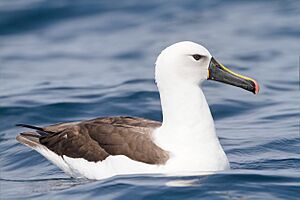Indian yellow-nosed albatross facts for kids
Quick facts for kids Indian yellow-nosed albatross |
|
|---|---|
 |
|
| Off the south-east coast of Tasmania | |
| Conservation status | |
| Scientific classification | |
| Genus: |
Thalassarche
|
| Species: |
carteri
|
| Synonyms | |
|
Thalassarche chlororhynchos carteri |
|
The Indian yellow-nosed albatross (Thalassarche carteri) is a type of albatross and the smallest of the mollymawks. It lives in the Indian Ocean. For a long time, scientists thought it was the same as the Atlantic yellow-nosed albatross. But in 2004, BirdLife International decided they were different species.
Contents
Understanding the Indian Yellow-Nosed Albatross
Mollymawks are a group of albatrosses. They belong to the family called Diomedeidae. This family is part of a larger group of birds known as Procellariiformes. Other birds in this group include shearwaters and storm petrels.
These birds have special features. They have unique nasal passages called naricorns on their upper beak. Their beaks are also special, made of seven to nine hard plates.
Albatrosses can make a special stomach oil. This oil is stored in their stomach. They use it to protect themselves from predators. It is also a rich food source for their chicks. Adults use it for energy during their very long flights.
They also have a salt gland above their nose. This gland helps remove salt from their bodies. This is important because they drink a lot of ocean water.
Physical Features of the Indian Yellow-Nosed Albatross

The Indian yellow-nosed albatross weighs about 2.55 kg (5.6 lb). It is about 76 cm (30 in) long. Its wings can spread out to 2 m (6.6 ft) wide.
Adult birds have a light grey or white head and neck. Their back, upper wings, and tail are dark grey. Their belly and underparts are white. The underside of their wings is white with a black tip. It also has a thin black edge at the front.
Their beak is black. It has a yellow stripe on the top ridge and a red tip. Young albatrosses have a white head and an all-black beak.
It can be hard to tell this albatross apart from others. It looks very similar to the grey-headed albatross. It also looks like the Atlantic yellow-nosed albatross. Some people still think they are the same species. You can tell it apart from the Atlantic yellow-nosed albatross by its head. The grey color on its head is lighter.
Albatross Behaviour
Reproduction and Life Cycle
Like all albatrosses, the Indian yellow-nosed albatross breeds in groups. They build their nests together in colonies. These birds breed once a year. Adults start having chicks when they are about eight years old.
They build their nests from mud. They choose bare, rocky areas. Sometimes they build nests in tussock grass or ferns. The female lays just one egg.
The nesting season starts in August. Eggs are usually laid around September or October. The parents take turns sitting on the egg. This incubation period lasts about 70 days. After the chick hatches, it takes about 115 days for it to grow. Then it is ready to fledge and fly on its own.
Feeding Habits
The Indian yellow-nosed albatross eats different kinds of food. They mainly feed on fish. They also eat crustaceans, like crabs and shrimp. Another food source for them is cephalopods, such as squid and octopus.
Where They Live and Breed
| Location | Population | Date | Trend |
|---|---|---|---|
| Amsterdam Island | 27,000 pair | 1997 | Declining |
| Prince Edward Islands | 7,500 pair | 2002 | Stable |
| Crozet Island | 7,030 pair | 2007 | |
| Kerguelen Island | 50 pair | 1998 | |
| Île Saint-Paul | 3 pair | 2007 | |
| Total | 65,000 | 2004 | Declining |
This albatross breeds on several islands in the Indian Ocean. These islands include Prince Edward Islands, the Crozet Islands, Kerguelen Island, Amsterdam Island, and St Paul Island.
When they are raising their chicks, adult birds fly far to find food. They can travel up to 1,500 km (930 mi) away from their nesting colony.
When they are not breeding, they live at sea. Their range stretches from South Africa across the Pacific Ocean. They can be found just beyond New Zealand. This area is generally between 30° S and 50° S.
Protecting the Indian Yellow-Nosed Albatross
The IUCN (International Union for Conservation of Nature) lists this albatross as an endangered species. This means their numbers have dropped a lot in the last 70 years.
There are two main reasons for this decline. One is interactions with longline fisheries. These are fishing boats that use very long lines with many hooks. Albatrosses can get caught on these hooks. The other reason is outbreaks of diseases. These include avian cholera and Erysipelothrix rhusiopathiae.
The total area where they live is about 35,300,000 km2 (13,600,000 sq mi). Their breeding area is much smaller, about 1,400 km2 (540 sq mi). In 2004, scientists estimated there were about 65,000 adult birds. This number is based on earlier counts. For example, 27,000 pairs bred on Amsterdam Island. About 7,500 pairs were on Prince Edward Island. These numbers show a decreasing trend.
Scientists are working to protect these birds. They are monitoring the birds on Amsterdam Island. They are also studying where the birds find food. The Prince Edward Islands are a nature preserve, which helps protect the birds there.
A vaccine has been created for some diseases, but it still needs to be tested. In 2006, the Indian Ocean Tuna Commission took action. They made it a rule for longline fishing boats to use a bird streamer. This streamer scares birds away from the fishing lines. This rule applies south of 30°S. Also, South Africa requires its boats to use different methods to help protect the albatrosses.



